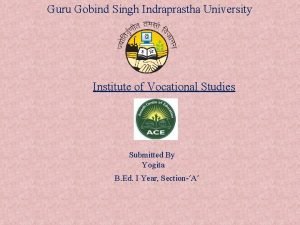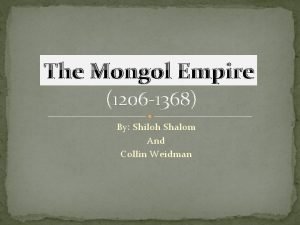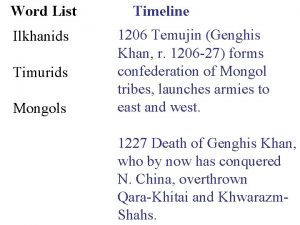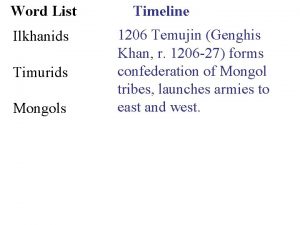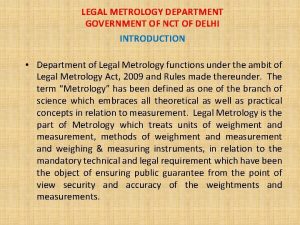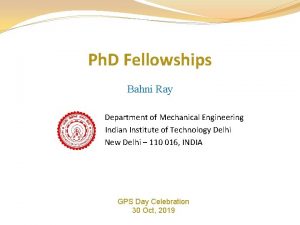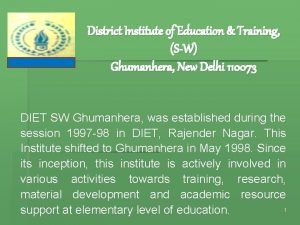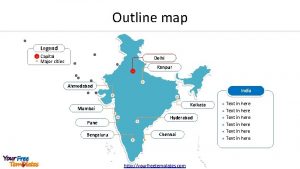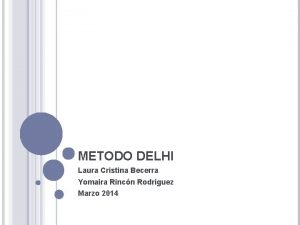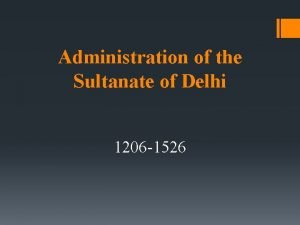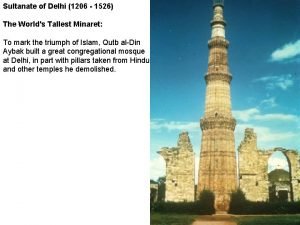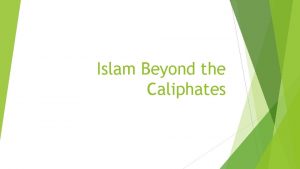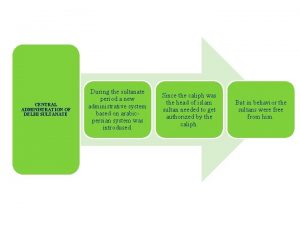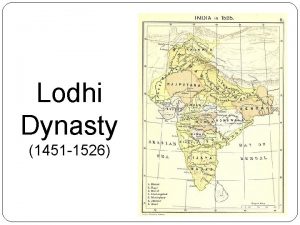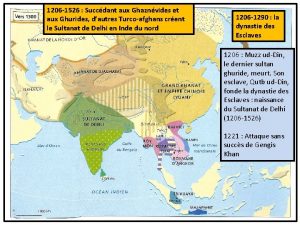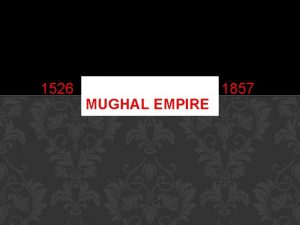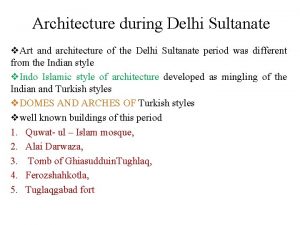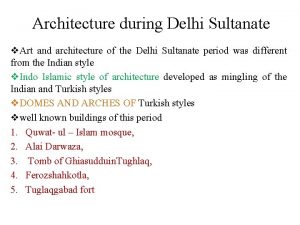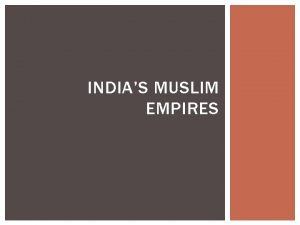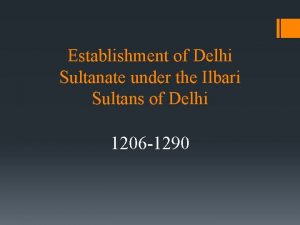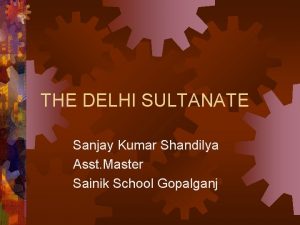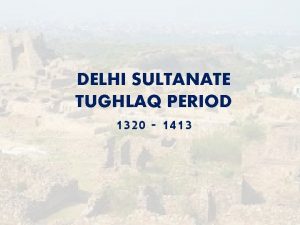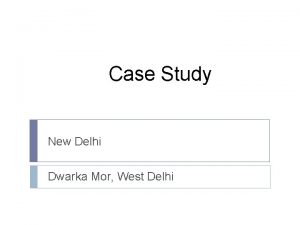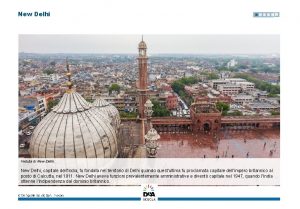HISTORY CHAPTER 3 THE DELHI SULTANATE 1206 1526




































- Slides: 36

HISTORY CHAPTER 3 THE DELHI SULTANATE ( 1206 - 1526 CE)

• Qutbuddin Aibak was the general of Mohammad Ghori appointed Aibak as the viceroy of his Indian conquests. Mohammad Ghori died in 1206 CE. As he left no descendants, his viceroys declared themselves independent. • -Qutbuddin Aibak claimed the Indian territories , which included Punjab, Sind, the Indo-Gangetic Plains, and present day Bihar and Bengal. He established his capital at Delhi.

• List of Slave dynasty Rulers • Qutb ud-Din Aibak(1206 -1210 AD) Aram Shah (1210 -1211 AD) Iltutmish(1211 -1236 AD) Rukn-ud-din Feroze(1236 AD) Razia al-Din(1236 -1240 AD) Muiz-ud-din Bahram(1240 -1242 AD) Ala-ud-din Masud(1242 -1246 AD) Nasiruddin Mahmud(1246 -1266 AD) Ghiyas -ud-din Balban (1266 -1286 AD) Muiz-uddin Muhammad Qaiqabad(1286 -1290 AD)

• With this the history of Delhi sultanate started which lasted for more than 300 years from 12061526 CE. The rulers called themselves sultan, so Delhi Sultanate. • - Five successive dynasties ruled over Delhi. They were • The Slave dynasty ( 1206 -1290 CE) • The Khaljis ( 1290 - 1320 CE) • The Tughlaqs ( 1320 - 1399 CE) • The Sayyids ( 1414 - 1451 CE) • The Lodis ( 1451 - 1526 CE)

The Slave Dynasty: • Qutbuddin Aibak established the Slave Dynasty. The rulers were also called the Mamluk Sultans of Delhi ( Mamluk means Slave). • Qutbuddin Aibak: ( 1206 -1210 CE) • Qutbuddin Aibak was originally a native of Turkistan. Aibak was the prime force behind Ghori’s victory in the Second Battle of Tarain. Qutbuddin conquered Ajmer, Jhansi, Delhi and Meerut.


Iltutmish


Ghiasuddin Balban


• He used marriages to strengthen his position- he married the daughter of Yaldoz, the governor of Kerman( Iran). Sister was married to Qabacha, the governor of Sind and his own daughter to Iltutmish, who succeeded him. • He was also a lover of art and literature. Hazar Nizami and Fakhr Ahmad were present in his court. He built the Quwwat ul Islam and Dhai din ka Jhopra mosques. He died in 1210 CE while playing polo.

• Iltutmish ( 1210 -1236 CE): • Took over the throne in 1210 CE). He assumed the title of Shamsuddin ( sun of the religion). He had to control the revolt of the nobles. ( a person with special social and political status. He defeated Yaldoz and occupied Lahore and Punjab. He also defeated Qabacha, the governor of Sind. He then brought under his control the Rajput chiefs of Ranthambor, Ajmer and Gwalior. He also controlled Bengal and Bihar. • The Mongols under the leadership of Chengiz Khan gained control over western Punjab. Iltutmish built a line of forts along the river Ravi to control him, but could not.

• Razia Sultana ( 1236 -1240 CE): • Razia was the first and the last woman who sat on the throne of Delhi. She was a great monarch- wise, just and generous. She faced the opposition from the ‘group of forty’- Turkish nobles and military leaders who controlled the politics of Delhi. She ruled only for 4 years. • After Razia, her younger brother Nasiruddin was put on the throne by Ghiasuddin Balban. For 20 years Balban managed the empire. But later he himself became the Sultan.

• Ghiasuddin Balban ( 1266 -1286 CE): • He believed in ruling with ‘iron and blood’. He stopped the attacks from Mongols. During his time also the Mongols tried to attack Delhi, but he held the Mongols away. • Balban died in 1287 CE and was succeeded by his grandson. On his death, the kingdom weakened leading to the collapse of Slave Dynasty.

• The Khaljis ( 1290 -1320 CE): • Balban’s grandson was put to death by an official of the Khalji tribe- Firoz Shah. The Khaljis were of Afghan origin. • Jalaluddin Khalji ( 1290 -1296 CE): • Firoz Shah ( 70 years) took the name of Jalaluddin. The Mongols tried to attacked Delhi, but Jalaluddin sent them back. He was killed by his nephew Alauddin Khalji and occupied the throne of Delhi.

• Alauddin Khalji ( 1296 -1316 CE): • Alauddin was known as a cruel and resolute ( determined) ruler. But African traveler Ibn Batuta considered him as ‘one of the best . His wish was to conquer the whole world but he could not.

Alauddin Khalji


• Conquests: ( control of a place or people by military force) • In 1297 CE, he annexed Gujarat, Malwa and Mewar and captured the forts of Ranthambhor and Chittor. In Gujarat he secured the services of Malik Kafur. He became the general of Alauddin’s army. Alauddin captured Devagiri in 1307 CE. He defeated the rulers of Warangal, Dvarasamudra and mysore. He collected the wealth of Madurai and Rameswaram. He was the first ruler to extend his kingdom to the south of the river Narmada.

• Administration: • Increased the size of his army. • Collected the lands from the priests and the other government officials. • The peasants paid tax ( in kind) directly to the state. • The land revenue was raised to half of the total produce. • He also took a check on the price of the commodities.

• Alauddin banned all banquets ( formal evening meal for many people) and assemblies. He also spread his spies across the empire. • Alauddin transformed the markets of Delhi. There were different markets for different goods. Weights and measures were checked. Made arrangements for godowns. Amir Khusrau was present in his court. • After Alauddin , his minor son was put on the throne by Malik Kafur. But, both of them were killed. In 1320 CE, the last Khalji ruler, Khusro Khan was killed by Ghiasuddin Tughlaq, the founder of Tughlaq dynasty.

• The Tughlaqs ( 1320 - 1399 CE): • Ghiasuddin Tughlaq was the founder of Tughlaq dynasty. He was killed by his son Juna Khan and ascended to power as Muhammad bin Tughlaq. • Muhammad bin Tughlaq: ( 1325 -1351 CE) • He was known as the confused genius. He thought ahead of times. His plans and intentions were good but carried out thoughtlessly and in a hurry, which resulted in their failure.

Facts and Information about Muhammad bin Tughluq Born 1290 AD at Kotla Tolay Khan in Multan Died March 20, 1351 in Sindh, Pakistan Nick Name Prince Fakhr Malik and Jauna Khan Wife Married to the daughter of the Raja of Dipalpur Father Religion Ghiyath al-Din Tughluq. Islam Reigned Ruled Tughluq dynesty from 1325 AD to 1351 AD Predecessor Successor Ghiyath al-Din Tughluq Firuz Shah Tughluq Tax During his reign, Tughluq imposed heavy tax in the land between the Ganga and the Yamuna rivers. Coinage He introduced a new coin made of silver, the adlis, and increased the size of the existing gold dinar from 172 grains to 202 grains. Campaign Tughluq held campaigns against Prataparudra, the king of the Kakatiya dynasty Most Famous Rebellions Deccan (1326, 1347), Mabar (1334), Bengal (1338), Gujarat (1345), and Sind (1350) Capital Transferred his capital in 1327 to Deogir (now Daulatabad) Books Muhammad Bin Tughluq by Cho Ramaswamy Movies Muhammad bin Tughluq’, directed by Cho Ramaswamy and produced by Prestige Productions




• The major projects started by Muhammad bin Tughlaq: • Shifting of the capital : In 1327 CE, he decided to shift his capital from Delhi to Devagiri, or Daulatabad, a city located 1400 km from Delhi. Daulatabad was at the centre of his empire. The people faced great hardship. It lest the north western frontiers of the empire exposed to attacks from the Mongols. So, he shifted back his capital. • Taxation in Delhi : When the fertile Ganga-Yamuna doab area was passing through great famine, he increased the tax. Farmers faced untold misery and riots broke out. He was forced to withdraw his order.

• Token currency : In 1330 CE, the sultan issued token coinage- i. e. , coins of brass and copper were stamped with a value equal to that of silver and circulated. It resulted in widespread fraud ( an act of deceiving). People started minting the coins at home. When there were more coins in circulation, there was problem in trade and commerce. Finally, Muhammad had to withdraw the token currency. • Expedition to the North-West: In 1337 -38 CE, He undertook an expedition ( a journey undertaken with a particular purpose) to China and Qarachil in the Kumaun- Gaehwal region of the Himalayas. It led to the death of all his soldiers excepting a few ( Ibn Batuta). All these schemes suffered due to the lack of proper planning.

• Administration: • Muhammad bin Tughlaq was an excellent administrator. His empire was one of the largest ever ruled by any Muslim ruler in India. He did much good for his people. He opened many hospitals, houses for the poor people and donated money to the scholars. He kept absolute power in his hand. He did not mix religion and administration. Revenue records of all the provinces were kept.

• Break-up of the Empire: • By 1330 CE, sultan began to lose control. By 1329 CE, the Mongols had already entered into India. By 1334, the empire began to decline. Rajputs recaptured their areas. There were revolts everywhere. In 1336 CE, the Vijayanagara empire was formed in the south. Muhammad died in 1351 CE while trying to put down revolt in Sind. • Firoz Shah Tughlaq (1351 - 1388 CE): • Cousin of Muhammad bin Tughlaq. He was a prolific ( plentiful) builders. He is known for the mosques and forts that he built.

• Sources of Information: We know about Muhammad bin Tughlaq from Ziauddin Barani ( spent 17 yrs in the court) and Foreign traveler Ibn Batuta. • Iqta system: Instead of salary, the nobles, officers and religious leaders were given pieces of land. They had to pay the king portion of the revenue they collected. They also had to maintain a body of troops. Firoz Shah made the iqtas hereditary. So, the iqtadars became powerful. • Land Tax: Muhammad bin Tughlaq raised the tax and Firoz Shah Tughlaq reduced it. All the rulers of the Tughlaqs tried to improve the condition of the people. They improved agriculture and irrigation. Opened hospitals and encouraged scholars through donations.

• The Role of Nobles: ( The nobles normally occupied the place next to the Sultan and played a key role in the administration of the state. Nobles comprised the ruling class and belonged to different tribes and nationalities like the Turkish, Afghan, Persian, Arabic, Egyptian and Indian Muslims). The stronger sultans tried to break the power of the nobles. During the rule of weak sultans, they emerged stronger than the sultan.

• The Invasion of Timur: • In 1398 CE, during the rule of Muhammad Tughlaq, the Delhi Sultanate was attacked by Timur. • Timur was a Central Asian Turk who had embraced Islam and set up kingdom in Samarkand. Timur entered Delhi and the city was destroyed and left in ruins. Timur also ransacked Meerut and Jammu. The Tughlaq empire never recovered from this blow.



 Delhi sultanate ap world history
Delhi sultanate ap world history India spice chart
India spice chart Slave khilji tughlaq lodi dynasty
Slave khilji tughlaq lodi dynasty Mansabdari system was introduced by
Mansabdari system was introduced by Tughlaq dynasty
Tughlaq dynasty 1206-1368
1206-1368 1368-1206
1368-1206 A word 1206
A word 1206 A word 1206
A word 1206 Westerlies
Westerlies Msc circular 1206
Msc circular 1206 Reglamento 1206/01
Reglamento 1206/01 Mughal empire
Mughal empire Yellowstone national park surveyed a random sample of 1526
Yellowstone national park surveyed a random sample of 1526 Bridal jewellery west delhi
Bridal jewellery west delhi Dpmi paramedical college delhi
Dpmi paramedical college delhi Huzur saran iit delhi
Huzur saran iit delhi Delhi fire service act 2007
Delhi fire service act 2007 Postcard new delhi answer key
Postcard new delhi answer key Metrology department delhi
Metrology department delhi Khurana & khurana advocates and ip attorneys (delhi branch)
Khurana & khurana advocates and ip attorneys (delhi branch) Dmse iitd
Dmse iitd Bahni ray iit delhi
Bahni ray iit delhi Naveen garg iit delhi
Naveen garg iit delhi 194d mva fine in delhi
194d mva fine in delhi Delhi house sopot
Delhi house sopot The crooked house poland
The crooked house poland Sjpu police
Sjpu police German language coaching in delhi
German language coaching in delhi Amss chennai data transmission
Amss chennai data transmission Gulshan manpower delhi
Gulshan manpower delhi D i e t, south-west, ghumman hera, new delhi-110073
D i e t, south-west, ghumman hera, new delhi-110073 Garima tiwari model
Garima tiwari model Delhi map outline
Delhi map outline Nss iit delhi
Nss iit delhi Metodo delhi
Metodo delhi Delhi to washington dc
Delhi to washington dc




